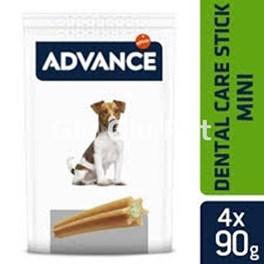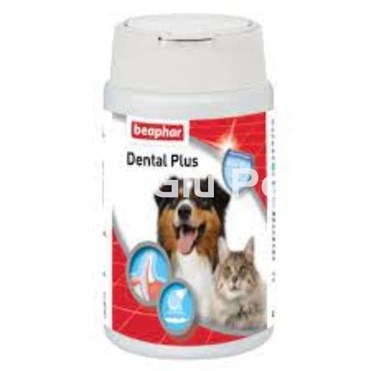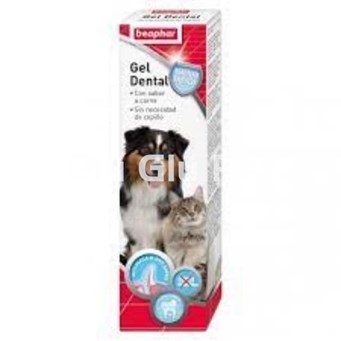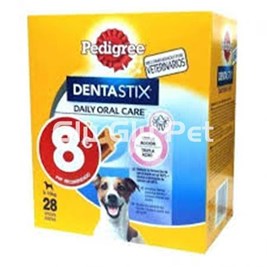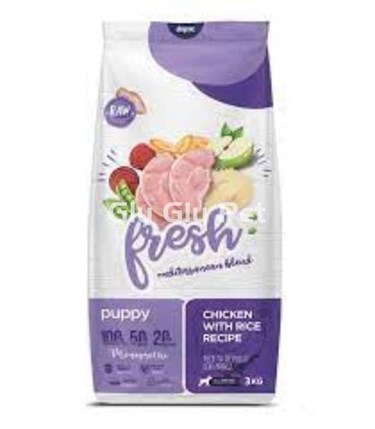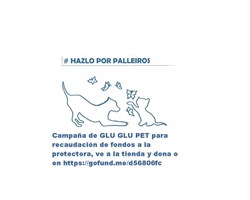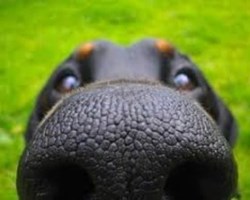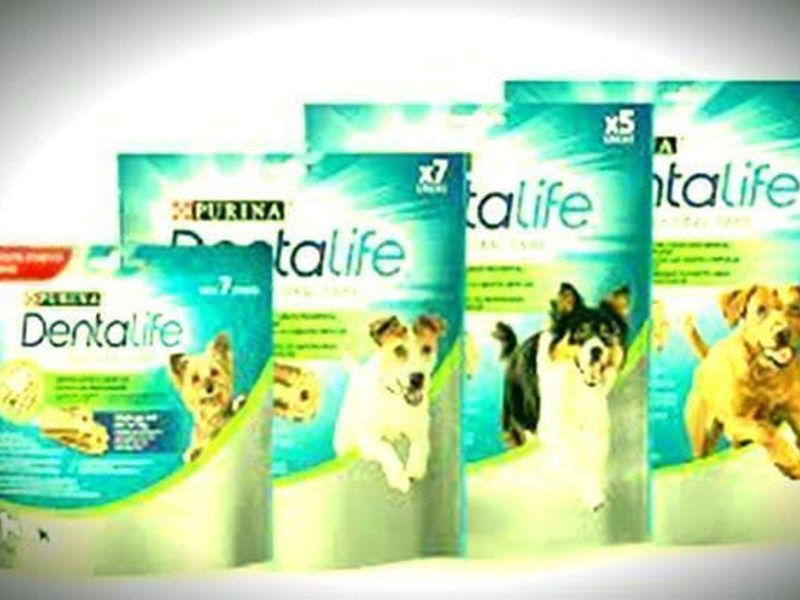
WHAT CAUSES BAD BREATH IN DOGS:
Many people believe that their dog's bad breath is as normal as tail wagging or coming home with muddy paws.
Bad breath can be the first sign of a dental health problem.
Dogs can suffer from dental problems.
But since they can't go to the dentist for a checkup, it's our responsibility to make sure their mouths are healthy.
HEALTH PROBLEMS ASSOCIATED WITH BAD BREATH:
Since dogs can't complain, it can be hard to tell if they have dental health issues.
It is important to know the signs that we should pay attention to and bad breath is one of the first signs that something is wrong.
There are two common dental health problems associated with bad breath: gingivitis and periodontal disease.
Gingivitis:
Gingivitis, a dental disease that affects both dogs and humans, is a disease of the gums as a reaction to plaque and can cause bad breath.
Other effects of gingivitis are redness, swelling and even bleeding of the gums.
Gingivitis is quite common in dogs, with more than 80% of pets over three years of age suffering from this problem.
Small breeds like Chihuahuas can be affected even earlier.
Gingivitis can usually be resolved with good dental hygiene, but if left untreated it can progress to periodontal disease.
The best way to avoid the problem is to take care of your pet's teeth every day, for example with a Purina® DentaLife® snack.
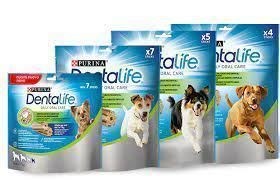
Periodontal disease:
Periodontal diseases are a group of dental problems that affect the tissue that supports your dog's teeth: the gums and jaw bones.
Periodontal diseases develop from the appearance of invisible pockets located between the dog's teeth and gums, which accumulate bacteria, this is the first phase of periodontal disease.
The accumulation of plaque then causes gingivitis, which progresses to affect the surrounding tissue.
The last phase of the disease involves bone loss and tooth loss, although it can also spread to other parts of the body, including your dog's heart, liver and kidneys.
There are other factors that can favor dental disease in some dogs: the breed, the arrangement of the teeth and the habit of chewing hard objects.
However, there are some measures you can take to minimize these risks: the key is to keep your pet's teeth clean, for example, with a Purina® DentaLife® snack a day.
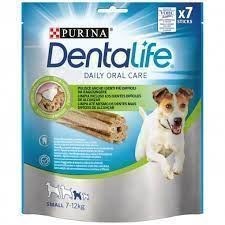
If you have doubts or questions about your dog's dental care, ask Glu Glu Pet for information and advice.
Purina® DentaLife® for dogs.
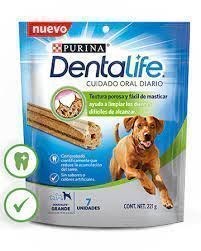
Your dog has specific health needs and maintaining healthy oral care contributes positively to his overall well-being. That's why the experts at Purina have developed Purina® DentaLife®.
This dental snack has a chewy porous texture, a special shape and a delicious chicken flavor.
Purina® DentaLife® reaches even hard-to-reach areas and daily use has been scientifically proven to help reduce tartar buildup, keeping teeth and gums healthy.
Variants of the product range:
For dogs Mini2kg-7 kg Bag of 7 units 69 grs. Maxi-pack of 21 units 207grs.
For small dogs 7kg-12 kgrs. Bag of 7 units 115 grs. Maxi-pack of 21 units 345 grs.
For medium dogs 12kg-25 kgrs. Bag of 5 units 115 grs. Maxi-pack of 15 units 345 grs.
For large dogs 25kg-40 kgrs. Bag of 4 units 142 grs. Maxi-pack of 12 units 425 grs.
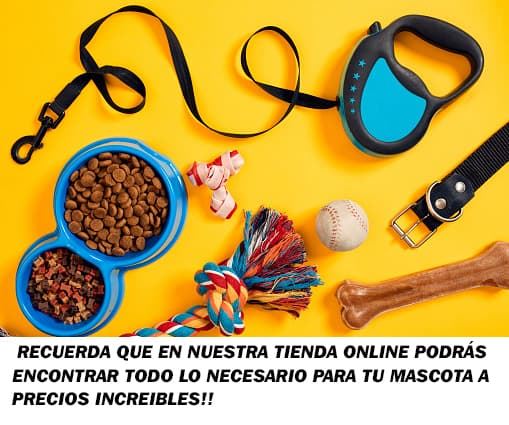
HOW TO CLEAN YOUR DOG'S TEETH:
Your dog's teeth and gums need the same attention as yours, that is, daily attention.
Daily dental care promotes a healthy mouth and helps your dog live a long and healthy life.
If left untreated for 3-5 days, the plaque combines with the minerals in your dog's saliva and hardens into tartar.
Tartar can irritate your dog's gums and create a rough surface on which more bacteria settle, leading to gingivitis: swelling and redness of the gums, and bad breath that won't go unnoticed.
Keeping your dog's teeth clean can help remove plaque.
Purina® DentaLife® is a dental treat for dogs that reduces tartar buildup, even on the hard-to-reach teeth at the back of the mouth, which are the most vulnerable.
Our dental snacks have been designed for daily use, since their daily consumption increases cleaning time.
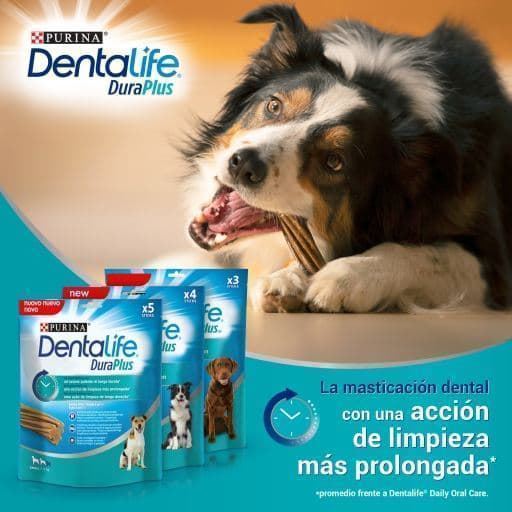
At regular dental check-ups, the vet will look at the various tender points to confirm that your dog's mouth is healthy.
This includes checking the dog's head and face for anything unusual.
He will carefully examine your mouth and the inner part of the lips, the surface of the teeth and the gums, including the most inaccessible internal areas, the tongue, the palate, the tonsils and the part under the tongue.
If your dog's teeth have tartar buildup, your vet may recommend removing it with a dental cleaning, which will be done under anesthesia to inconvenience your dog as little as possible.
This professional dental cleaning (called prophylaxis) may include:
- Rinse the mouth with an antibacterial solution.
- Clean teeth with manual and ultrasonic scalers to remove tartar buildup above and below the gum line.
- Use a special solution that marks out those spots where plaque remains, and remove it.
- Polish the teeth to remove microscopic grooves.
- Check each tooth, and the surrounding gums, for signs of disease.
- Extract teeth that cannot be repaired.
The vet, after leaving your dog's teeth impeccable, will give you some advice so you can keep it that way.
By cleaning your dog's teeth at home you can take responsibility for his regular dental care, reduce visits to the vet, and help keep your dog's teeth and gums in tip-top condition.
FIGHT BAD BREATH IN DOGS:
You may have noticed that your dog has bad breath and you don't like receiving his signs of affection, especially when he wants to lick you!
If your dog has bad breath, you need to go to the vet to rule out any serious problems, such as gum disease or tooth decay.
It may be normal for your dog to have bad breath, even if they don't have gum problems.
Every dog is different and some have stronger breath than others.
This can vary based on the foods they eat, the amount of water they drink, and even their unique quirks.
If your dog is healthy and happy, but his mouth smells like lightning and your vet has ruled out an underlying condition, you can try a number of steps at home to help reduce bad breath.
These steps can also help a dog that has been diagnosed with gum disease, though it's important to talk to your vet before trying anything on your own:
Brushing the dog's teeth: cleaning his teeth with a brush can help in cases of bad breath. Cleaning your dog's teeth can be easily done at home if you have the right equipment. There are several different toothbrushes and toothpastes for dogs; We recommend that you consult with your veterinarian to find out which is the best for yours. Find more information about brushing your teeth here.
Add parsley to food: parsley is fantastic for improving bad breath in dogs, as it is a natural deodorant. If you cut a little bit and put it in the food, you will help improve the problem. Remember, that at Glu Glu Pet we recommend that you feed your dog a complete and balanced diet in the form of dry or wet feed, so parsley is not vital for its nutritional needs. Use only a small amount, because the taste will confuse him
Diet: Feed a good quality, complete diet, a poor diet could lead to bad breath as well as nutritional deficiencies. Many dogs with bad breath tend to eat sugary or high-fat foods and treats as treats. These treats stimulate the growth of bacteria on the teeth and, if nothing is done, can cause a number of dental conditions, including bad breath.
If your pet has bad breath, think about the treats you give him or the treats he grabs when you don't realize it.
The best snacks are those designed especially for dogs, as they will be nutritionally safe and can even help improve their dental hygiene.
DentaLife®: Giving your dog one DentaLife® bar a day is an excellent way to help reduce bad breath.
Chewing a DentaLife® bar can help reduce plaque buildup in your mouth, even in the toughest places: the pieces right at the back.
Plaque is one of the main causes of bad breath, so keeping it under control is also a good way to ensure your dog's breath is as fresh as possible.
Teeth cleaning at the vet: If you're having trouble cleaning your dog's teeth at home or the cleaning doesn't seem to be working, ask your vet if he can clean your dog's teeth. Professionals have more practice getting into those harder-to-reach areas and will often be able to get a more thorough clean than you could.
Flossing – Flossing is a great way to help reduce plaque buildup on your teeth. This in turn can help reduce bad breath. This is because some teeth grow so close together and there is so little space between them that the brush cannot reach, but dental floss could get between the pieces.
This method of reducing bad breath in dogs is not always helpful, as most dogs have teeth that are farther apart than humans.
If your dog has teeth that are close together, he can go very well for dental care.
Your vet will be able to tell you if you can floss with him or if he will be fine.
Bad breath could mean that there is an illness that you need to treat.
Although it is normal for dogs to have bad breath, it could be a sign of a more serious problem.
WHY IS TOO MUCH PLAQUE DANGEROUS?:
We already know that too much plaque can lead to problems with our teeth.
Plaque is a sticky film that builds up on your and your dog's teeth.
This sticky film is made of bacteria and starts when food that is eaten remains on the teeth.
If not cleaned, this bacteria begins to grow.
The more bacteria that grow on the dog's teeth, the greater the risk of dental disease.
HOW DOES PLAQUE BUILD UP?
Plaque on the dog's teeth begins to build up after eating.
It happens by a chemical reaction caused by bacteria in the mouth, food and saliva.
When all three combine, this reaction occurs and plaque begins to build up.
Certain foods are more likely to accelerate plaque buildup in dogs compared to other foods.
Bacteria love the carbohydrates in sugar, which means giving your dog sugary foods could increase plaque buildup in his mouth.
Eventually this plaque hardens and the dog will build up tartar.
Signs that the dog has too much plaque.
There are several symptoms that you should be aware of when examining the dog's mouth. In your dog's mouth do you see...?
- Swollen gums.
- discolored teeth
- Loss of teeth.
- Bad breath .
- Pus inside the mouth.
If your dog shows any of the above symptoms, you should contact your vet and seek advice before trying plaque removal methods.
WHY IS IT NOT ADVISABLE FOR A DOG TO HAVE A PLAQUE?
A large accumulation of plaque can be a real problem for the dog.
When plaque hardens, it becomes tartar.
A dog with tartar could suffer from various diseases, for example:
Gingivitis: This gum condition is perhaps one of the most well-known oral conditions. In the early stages of gingivitis, the dog will have bad breath. There will also be a buildup of yellow tartar on the teeth. If this is not treated, the gums may begin to swell and a red line may appear across the gums. The final stages of gingivitis can open the door to different forms of gum disease along with loss of some teeth.
Periodontal disease: If gingivitis is not treated, it can lead to periodontal disease. This disease causes the gums to recede. When this happens, a cavity remains that can become infected and, if left untreated, destroy the gum and the tissue that supports the tooth.
Abscesses: An abscess is a collection of pus around one or more teeth. This pus causes the gum around the tooth to swell and turn red. The more pus in the dog's mouth, the more it will hurt. That's why it's important to regularly open his mouth and take a look at his teeth.
ARE SOME BREEDS MORE PRONE TO DENTAL DISEASE?
Yes, certain breeds of dogs are more prone to dental disease than others.
Small dogs and toy breeds tend to be more prone to dental problems.
This is because small breeds have smaller mouths, which means there is a higher risk of dental crowding.
This crowding can damage the teeth and lead to more plaque or other dental conditions.
Another downside to having a small mouth is that dog plaque and tartar tend to build up quickly.
This excess tartar buildup can lead to many serious dental problems.
Whether you have a small dog or not, dental care is important.
For more information, check out our dental tips:
- How to clean our dog's teeth.
- Buy our new BEAPHAR products to combat your cat's bad breath and dental health.
- Buy our new BEAPHAR products to combat your dog's bad breath and dental health.
- The Airedale terrier breed, the king of terriers.
- All the best to the Afghan hound.
- The best hygiene for your dog.
- Breed of Dog: CHIHUAHUA.
- Brushing our dog or cat.
- How to clean our dog's teeth.
Other Glu Glu Pet products that might interest you:
- Advance Dental Snacks mini dogs 7 pcs.
- Oral Water 250ml.
- Dental plus Beephar.
- DENTASTIX MONTHLY BOX 5-10kg.
- Beaphar Dental Gel 100g.
- OROZYME ENZYMATIC TOOTHPASTE GEL.
- Dental Pack (paste and brush).
- Beaphar toothpaste 100g.
- Virbac VET AQUADENT 250 ml.
- IMAGINE LAMB & RICE.
- IMAGINE LARGE ADULT 15KG.
- IMAGINE LARGE PUPPY.
- IMAGINE LIGHT.
- IMAGINE Mature 3kg.
